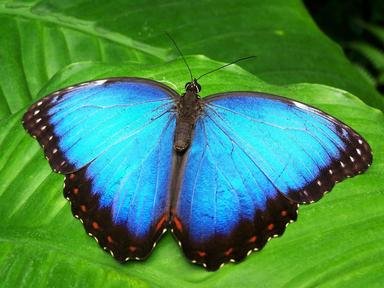Quiz Answer Key and Fun Facts
1. The smallest English butterfly, it is more brown than blue. Its scientific names mean 'Roman god of love' and 'smallest'.
2. The eyes on this stunning butterfly's wings are said to scare birds away, but that is debatable. Its scientific names are 'a girl beloved by Zeus and transformed into a heifer by him' and 'the girl's father'.
3. A very pretty butterfly found in great numbers in gardens on buddleia and sedum. It has lovely markings in orange, cream/yellow and blue, and its scientific names mean 'beautiful' and 'nettles'.
4. A harbinger of summer, this butterfly is often seen on bluebells or dancing over its main foodplant, garlic mustard. Its scientific names mean 'bitter-cress' and 'grace of a flower'.
5. In a good year, millions of these remarkable butterflies swarm into England from North Africa. They can't overwinter in the British climate. Its scientific names mean 'a mountain, birthplace of the goddess Diana' and 'thistles'.
6. Perhaps the most well-known of English butterflies though by no means the most common, it has bright orange and white markings on velvety black upper wings. Its scientific names are 'a poet's heroine' and 'a beautiful mythical female athlete who killed her suitors when they lost to her in a race'.
7. Ragged wings and blur of orange brown - that's how you first spot this butterfly. However if you can get close to it, you will see a curious white mark on the underwings. Its scientific name means 'many angles' and 'white discal mark'.
8. A royal treetop inhabitant, rarely seen except when it glides majestically to the forest floor to drink from puddles. Its scientific name may mean 'deceptive tail' and 'messenger of the gods'.
9. Perhaps the most exotically coloured blue butterfly in England, with metallic azure wings that look electric in the sunshine. Its scientific name means 'an Egyptian princess' and 'beautiful, hundred-eyed guardian' though its English name is more apt.
10. And finally, our most exotic butterfly, full stop. It resembles the bird whose name it carries, and is found only in certain fens in east Anglia. Its scientific name means 'butterfly' and 'a doctor who served with the Greeks in the Trojan war'.
Source: Author
Rhubarbeater
This quiz was reviewed by FunTrivia editor
Tizzabelle before going online.
Any errors found in FunTrivia content are routinely corrected through our feedback system.

